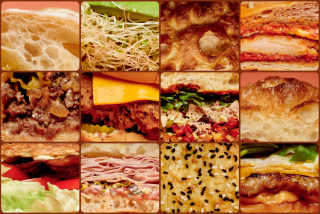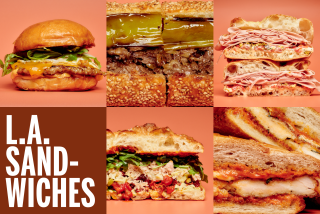Food for Thought : Whatever Happened to the Plain Bread-and-Butter Sandwich?
- Share via
Lettuce? There’s nothing but lettuce in your sandwich?” people ask. Absolutely nothing nicer. I thought I had invented the lettuce sandwich, but I have since read of the English serving them up along with the more-effete cucumber sandwiches.
It’s such an unbeatable combination of virtue and vice. There you are, making a sandwich of nothing but pure, calorie-free lettuce, but there is that hidden slap of mayonnaise between the lettuce leaves, amplifying the more modest slathering on each bread slice. Then, too, there are the two delightful opposites: the crunch that only cold, crisp lettuce gives, played against the softness of that squishy white bread.
It is intrinsic to white-bread sandwiches--one must not look upon it as an irritation--that the top half of the sandwich immediately clings to the roof of your mouth with the fixing power of cement, frequently requiring a covert finger to dislodge it. (My unorthodox daughter toasts the bread first--”Then, instead of gluing to the roof of your mouth, it just scrapes it like razor blades.”) Wheat bread? Oh, come now, that’s not playing the game.
It’s odd how one cuts sandwiches. Lettuce sandwiches should always be cut straight down the middle, vertically; there is no other way. The same with peanut butter sandwiches. With tuna fish sandwiches, I have catholic cutting tastes; they may be cut in half, vertically or diagonally, or into four squares. Deviled-egg sandwiches may be cut into triangles. Or into halves, or any way you like, just so long as you give me one. And while we’re on the subject, isn’t it strange that sliced-egg sandwiches are such a completely different kettle of fish from deviled-egg sandwiches? I don’t know why, but they are. And fried-egg sandwiches? They’re eaten by log haulers at midnight truck stops. I have never had the temerity to try a fried-egg sandwich.
And whatever happened to the plain bread-and- butter sandwich? It was joyously acceptable when I was growing up. “Bread and butter? That’s no sandwich!” said my daughter at age 4. I think it’s hard to beat a good bread-and-butter sandwich. We carried them to school in little, woven, green-and-yellow baskets. In fact, my mother made party versions on rare occasions, checkerboard sandwiches, which, when sliced, exhibited half-inch squares of brown-and-white bread mortared together with butter.
Watercress sandwiches, the tightly rolled-up kind, are, of course, the royalty of the sandwich world, with those delicate whirlpools of green and white. Anyone who puts anything other than butter with them deserves to be shot. I once was derided for making primitive versions from hastily pulled creek watercress on a long trip back from Arizona. “What! Those muddy things?” everyone cried. They all asked for seconds and thirds, mud or no.
As with salads, sandwiches with nuts in them should be outlawed. No amount of cream cheese is going to make them edible. Likewise for dates. And I’m sorry but I still cannot face open-face sandwiches with delight; I feel cheated. Unless they’re deviled egg. Or pimiento cheese. And why did all those pimiento sandwiches, so ridiculously cheery with their pinkish complexions and rosy red bits, fall into disfavor after the ‘40s? And how I admired those party loaves, all “frosted,” the recipe books said, in cream cheese, hiding ribbon after ribbon of different-colored fillings.
Backward glances, back into sunny childhood, are what dictate our choice of plates today. Blue-and-white plates for the lettuce, the peanut butter, the bread and butter; homey everyday plates for homey everyday sandwiches--while the fancier sandwiches, those cut in triangles or diamonds, demand the green-glass octagonal plate.
Ah, tradition lays a heavy hand upon what and how we eat. Perhaps that’s why I’m invariably uncomfortable when confronted with a sandwich bristling with sprouts.
More to Read
Eat your way across L.A.
Get our weekly Tasting Notes newsletter for reviews, news and more.
You may occasionally receive promotional content from the Los Angeles Times.










